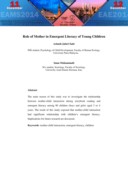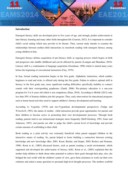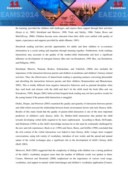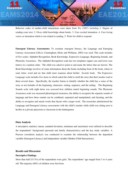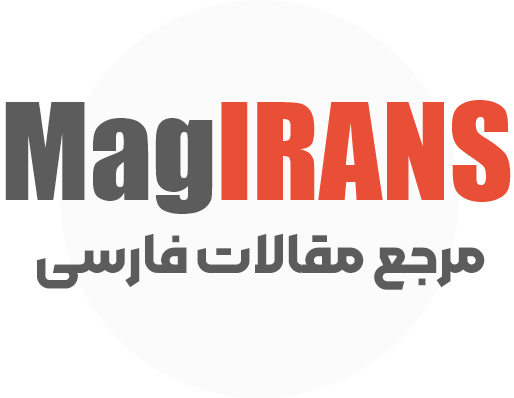بخشی از مقاله
Abstract
The main reason of this study was to investigate the relationship between mother-child interaction during storybook reading and emergent literacy among 90 children (boys and girls) aged 3 to 4 years. The result of this study exposed that mother-child interaction
KDG VLJQLILFDQW UHODWLRQVKLS ZLWK FKLOGUHQʼV HPHUJHQW literacy. Implications for future research are discussed.
Keywords: mother-child interaction, emergent literacy, children
Introduction
Emergent literacy skills are developed prior to five years of age, and strongly predict achievement in later literacy learning and many other fields throughout life (Coursin, 2012). It is important to consider child's social setting which may provide to be literate. Then, current study intends to examine the relationships between mother-child interactions in storybook reading with emergent literacy among young children in Iran.
Emergent literacy defines acquisition of pre-literacy skills as ongoing process which begins at birth and progresses into middle childhood and can be affected by parents (Lonigan and Shanahan, 2010). Literacy skill is a continuation of language acquisition (Goodman, 1998) which is started many years before the beginning of conventional instruction (Clay, 1979).
In Iran, formal reading instruction begins in the first grade. Alphabetic instruction, which enables beginners to read and write, is offered only during the first grade. Failure to achieve optimal skill in literacy in the first grade may cause significant reading difficulties specifically inability to connect sounds with their corresponding graphemes (Zandi, 2006). Pre-primary education is a one-year program for 5 to 6 years old which is not compulsory (Kian, 2010). According to Mofidi (2012) only less than 50% of Iranian children join this program. Thus, early intervention for educational programs such as home-based activities need to support childrenʼV OLWHUDF\ GHYHORSPHQW DQG OHDUQLQJ.
According to Vygotsky (1978) and neo-Vygotskian developmental perspectives (Tudge and Winterhoff, 1993), the nature of mother -child interaction provide great opportunities for parents and their children to become active in promoting their own developmental processes. Through book reading, parents tend to use instructional strategies more frequently (Hoff-Ginsberg, 1991; Jones and Adamson, 1987), and parents are able to judge the child's current level of knowledge and provide certain amounts of scaffolding to their child.
Book reading as a joint activity was extremely beneficial when parent engaged children in the interactive nature of reading. So, parent helped to foster building a connection between existing knowledge and new knowledge (Bus, 2001; Korat, Bachar, and Snapir, 2003; Roskos and Neuman, 1998). Korat et al., (2003) discussed factors, such as parent creating a social environment, which supported and developed the achievement of literacy skills. Korat et al., (2003) explained that the mother help children to think about other potential to achieve their goals through their play; also, she
EULGJHG WKH UHDO ZRUOG ZLWK WKH FKLOGUHQʼV SRLQW RI YLHZ' JDYH WKHP DVVLVWDQFH WR ZRUN RXW WKHLU RZQ solutions and asked a many questions to persuade high-level thought processes. The mothers scaffold
the learning, provided the children with challenges, and express them support through their activities (Korat et al., 2003; Strickland and Morrow, 1990; Teale and Sulzby, 1986; Yaden, Rowe and MacGillvray, 2000). Children become more educated when their skills were unified with quality of inputs, expectances and supports provided by adults (Bruner, 1983).
Storybook reading activities provide opportunities for adults and their children to co-construct information in a social setting and negotiate through meaning together. Furthermore, book readings interactions may associate to the quality of the mother-child relationship and have a significant influence on development of emergent literacy (Bus and van IJzendoorn, 1995; Bus, van IJzendoorn, and Pelligrini, 1995).
Strickland, Morrow, Neuman, Roskos, Schickedanz, and Vukelich, (2004) also included the importance of the interaction between parents and children in mealtimes and childrHQʼV OLWHUDF\-related activities. Thus, the effectiveness of shared book reading is operating manners converting pleasurable and absorbing the interactions between parents and their children (Sonnenschein and Munsterman, 2002). This is totally different from negative interactive behaviors such as parental discipline when
WKH\ UHDG ERRN DQG LQWHUDFW ZLWK WKH FKLOG DQG GRQʼW OHW WKH FKLOG WRXFK WKH ERRN (%XV DQG YDQ
IJzendoorn, 1995). Bergin (2001) believed that frequent book reading may not have positive results for the young learner if the parent-child interaction is struggled.

